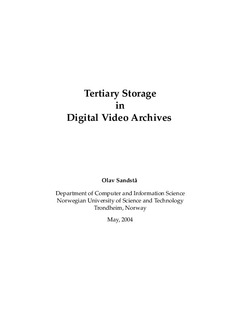| dc.contributor.advisor | Midtstraum, Roger | nb_NO |
| dc.contributor.advisor | Bratbergsengen, Kjell | nb_NO |
| dc.contributor.author | Sandstå, Olav | nb_NO |
| dc.date.accessioned | 2014-12-19T13:30:23Z | |
| dc.date.available | 2014-12-19T13:30:23Z | |
| dc.date.created | 2004-10-29 | nb_NO |
| dc.date.issued | 2004 | nb_NO |
| dc.identifier | 124941 | nb_NO |
| dc.identifier.isbn | 82-471-6445-0 | nb_NO |
| dc.identifier.uri | http://hdl.handle.net/11250/249961 | |
| dc.description.abstract | In order to efficiently manage the large amounts of video data stored in a digital video archive, computerized management systems must be developed for storing and making the video available to users. In this thesis, we study tertiary storage technologies and storage architectures for storing and retrieving digital video in video archives.
We evaluate serpentine tape as a storage medium for digital video. In order to increase the performance of storage systems using serpentine tape, we present and evaluate a detailed access-time model for serpentine tape and a novel scheduling algorithm for optimizing concurrent accesses to the tape. The scheduling algorithm is used for evaluating serpentine tape for storing images and video sequences. The main conclusion is that by using the access-time model and the proposed scheduling algorithm, it is possible to achieve significant improvements in initial latency, average access time, and the number of requests that can be served by a single tape drive.
Tertiary storage technologies including magnetic tape and DVD are evaluated for use in digital video archives. The evaluation is performed using a simulator of the storage system of a video archive. The simulation model is based on the architecture of the Elvira~II video archive server. Different configurations for the storage system are evaluated with regards to performance and cost. In the evaluation different allocation strategies, access distributions, and user loads are studied. The effect of using a cache based on magnetic disks is investigated.
The main conclusion is that the choice of architecture and storage technology for a video archive depends on the user generated load, the size of the requested video sequences, and the access distribution for the stored videos. It also depends on whether throughput, response time, storage cost, or cost per retrieved video is the main evaluation criterion. Furthermore, we show that a video archive based on DVD as the main storage technology outperforms a video archive using magnetic tape, and that including a relatively small disk cache in most cases improves the performance and reduces the total cost of the archive.
The ideas and results presented in this thesis are also useful outside the video archive context. The strategies and results are beneficial for applications that require hierarchical storage management systems for managing large data volumes. | nb_NO |
| dc.language | eng | nb_NO |
| dc.publisher | Fakultet for informasjonsteknologi, matematikk og elektroteknikk | nb_NO |
| dc.relation.ispartofseries | Doktoravhandlinger ved NTNU, 1503-8181; 2004:112 | nb_NO |
| dc.subject | Datorteknik | en_GB |
| dc.subject | TECHNOLOGY: Information technology: Computer engineering | en_GB |
| dc.title | Tertiary Storage in Digital Video Archives | nb_NO |
| dc.title.alternative | Bruk av tertiære lagringsmedia i digitale videoarkiv | nb_NO |
| dc.type | Doctoral thesis | nb_NO |
| dc.source.pagenumber | 365 | nb_NO |
| dc.contributor.department | Norges teknisk-naturvitenskapelige universitet, Fakultet for informasjonsteknologi, matematikk og elektroteknikk, Institutt for datateknikk og informasjonsvitenskap | nb_NO |
| dc.description.degree | dr.ing. | nb_NO |
| dc.description.degree | dr.ing. | en_GB |
